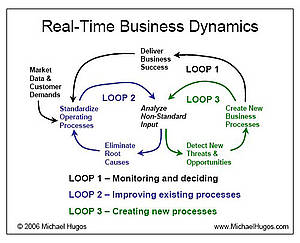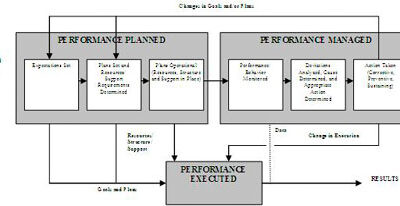The most profound innovation since the assembly line is staring us right in the face. But we don’t see it because we are so busy looking for something else. For most of us the word “innovation” still conjures up images of amazing new gadgets such as technology to turn water into gasoline, black boxes to project moving 3D holograms from our TV sets, and bio-tech breakthroughs that reverse the aging process.
Articles by: BPMInstitute.org
BPMS Watch: Measure Then Model? An Alternative Process Lifecycle
BPM users are familiar with the process lifecycle. It starts with process modeling. Business analysts document the as-is process, and analyze its shortcomings – handoff inefficiencies, exception handling, inconsistent application of policies and rules. From the model they can define KPIs for the process and estimate their value using simulation analysis. Then they model proposed process improvements, and project the expected benefit using simulation, before committing resources to the implementation.
The next step in the standard lifecycle is process design.
Can your Enterprise See, and Mashup, the Emerging Web?
Web 2.0 is one of those marketing words I don’t like to use that often, but unlike SOA 2.0, the Web 2.0 is a reality. It’s really a change in platform at its essence, but there are also many social issues there as well…information sharing, collaboration, and social networking to name a few. But can your enterprise see the emerging Web?
What’s important to remember is that there is a huge resource that is being created on the Web these days.
Where It Begins: The Super-System View
In a bulletin last year I wrote about the value of defining an organization’s processes by using a Processing System Hierarchy, which identifies and links “levels” of process, starting with the external environment and then cascading down through the organization’s value chain, primary processing systems, key processes and sub-processes, and finally down to individual performers. In this article I am focusing where the Hierarchy starts.
At this topmost level is what we at the Performance Design Lab (PDL) call the “Super System” view.
Key Drivers for BPMS Growth
Forrester has predicted that the BPMS (business process management system) market will grow from $1.2 billion in 2005 to over $2.7 billion in 2009. What is driving this growth? The tools are forging tighter links between IT and business users and significantly enhancing the effectiveness of process improvement efforts. Specifically, BPMS tools support:
The Hartford Moves Forward with SOA
Founded in 1810, The Hartford Financial Services Group is one of America’s oldest and largest financial institutions. From its origin in providing fire insurance to Connecticut businesses, it has become a leading provider of automobile, homeowners’ and business insurance.
Addicted to Code
Observations:
Do you notice how quickly business rules often turn into CodeSpeak? Instead of fully expressing business rules in the natural language of the business, a rules analyst sometimes expresses the business rules only in a structured syntax form or they quickly transform the incomplete or incoherent natural language form into a structured syntax form. The structured syntax form is usually an “If then Else” structure or decision table structure.
Making Sense of SOA Standards Activities – Part II
In the first part of this series, we talked about the confusion in the SOA space and the difficulty in understanding the various standards activities.
Integrating Business Process Management with Public Sector IT Management
John Wilson is an IT Specialist and Project Manager at the Nuclear Regulatory Commission (NRC). His previous federal government experience included management positions at the Smithsonian Institution and the National Institutes of Health.
Wilson pointed out that the federal sector spends a considerable amount of money on IT. For fiscal year 2005 they spent $65B and in 2006 they expect to spend over $200B.
John Wilson is an IT Specialist and Project Manager at the Nuclear Regulatory Commission (NRC). His previous federal government experience included management positions at the Smithsonian Institution and the National Institutes of Health.
Wilson pointed out that the federal sector spends a considerable amount of money on IT. For fiscal year 2005 they spent $65B and in 2006 they expect to spend over $200B. That is a lot of money and it underscores the strong need for business process management in the public sector.
Where Have All the Leaders Gone? The Long-Lost Executive Process Improvement Project
Look at any book on business process management or improvement these days and you’ll see a good amount of advice being expended on the creating, chartering, nurturing and managing of process design, or improvement, teams. Typically, these are made up of employees who perform the processes being improved along with a gaggle of supporters, technical experts, and the like.

















